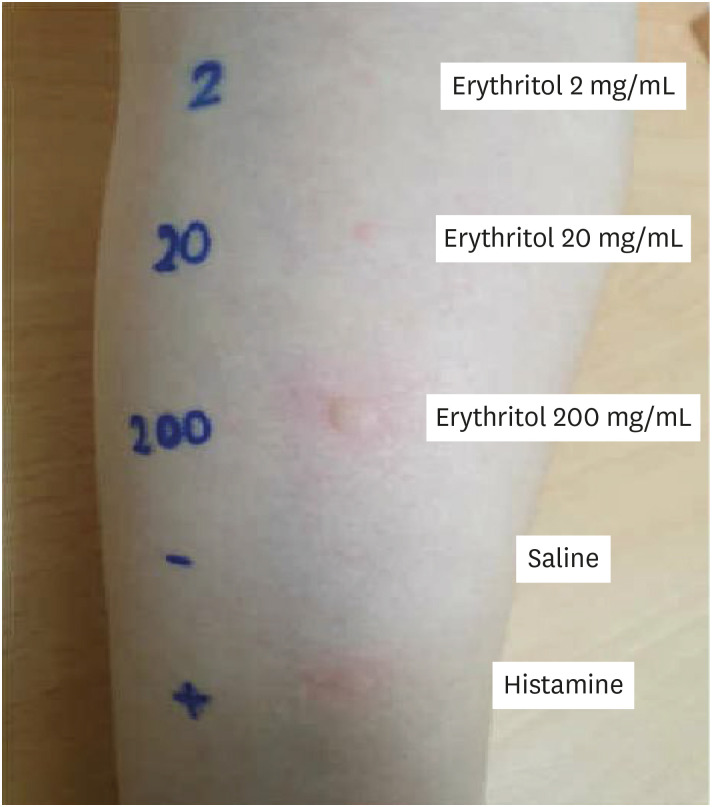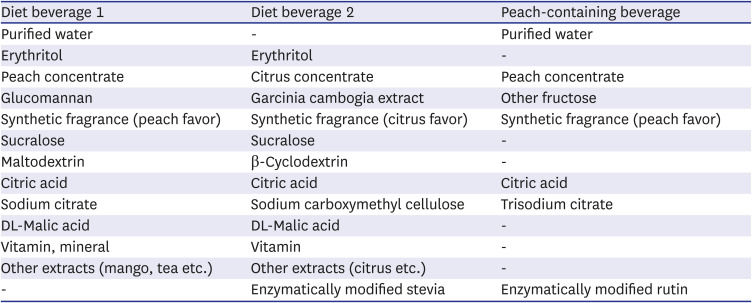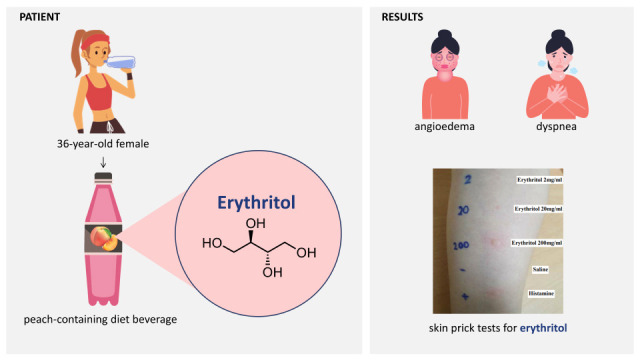INTRODUCTION
A food allergy is an adverse immune response to a food. Although an allergy can be triggered by almost any food, the major known allergens are milk, egg, nuts, and seafood.
1 There have been few reports of allergic reactions to food additives, with most population-based studies estimating the prevalence to be < 1% in adults and 2% in children.
2
Erythritol, a natural sugar alcohol found in some fruits and fermented foods, is used as a sweetener in beverages, candies, gums, chocolates, ice creams, etc., because it is low in calories.
3 It also acts as a caries inhibitor in combination with xylitol because of its humectant function.
4 Erythritol is also included in some toothpastes, mouthwashes, lotions, and make-up products.
4 A few cases of erythritol-induced allergic reactions have been reported in Europe and Japan.
56 In Spain, a 61-year-old woman presented with anaphylaxis after eating an ice cream containing erythritol.
5 A Japanese woman experienced allergic urticaria after drinking a canned tea (with milk) product containing erythritol.
6 All allergic reactions to erythritol reported to date developed after ingestion. To our knowledge, no allergic reactions to erythritol have been reported in Korea. Here, we describe a case of anaphylaxis caused by erythritol in Korea.
Go to :

CASE DESCRIPTION
A 36-year-old woman without any medical or surgical history presented to the emergency department with dyspnea and facial edema after drinking a peach-containing diet beverage (diet beverage 1). Her blood pressure was 70/40 mmHg. Blood laboratory test results and chest X-ray findings were normal. She was treated with intravenous chlorpheniramine, 125 mg methylprednisolone, and 0.3 mg epinephrine by intramuscular injection. Her symptoms improved, and she was discharged.
The patient was followed up through the outpatient department after this first event. She had a history of developing acute urticaria after consuming a dietary beverage containing peach components. There were no specific serum-specific immunoglobulin E (IgE) findings in analysis of peach components or multiple simultaneous allergen tests for various foods. The patient went home with a plan to have skin prick tests (SPTs) performed 4 weeks after the symptoms disappeared.
After 10 days, she presented to the emergency department again with urticaria and generalized itching after consuming a different type of diet beverage (diet beverage 2). She improved after the administration of an antihistamine and methylprednisolone.
SPTs were performed with a peach (using a prick-to-prick test), the two ingested diet beverages, and another peach-containing beverage that the patient had never consumed. Histamine and saline solutions were used as positive and negative controls. Wheals exceeding 3 mm were considered positive. The SPT results for the peach and the peach-containing product were negative. SPTs performed with the two diet beverages revealed positive results with wheal sizes of 6 × 4 and 3 × 3 mm, respectively (
Table 1).
Table 1
Skin prick test results for diet beverages

|
Test agents |
Wheal, mm × mm |
Erythema, mm × mm |
|
Histamine |
7 × 4 |
27 × 15 |
|
Saline |
1 × 1 |
2 × 2 |
|
Diet beverage 1 |
6 × 4 |
32 × 20 |
|
Diet beverage 2 |
3 × 3 |
18 × 13 |
|
Peach-containing beverage |
1 × 1 |
2 × 2 |

The ingredients contained in the dietary beverages were compared, and both products were found to contain erythritol (
Table 2). We performed SPTs with 2, 20, and 200 mg/mL erythritol solution dissolved in normal saline. The patient exhibited a positive response to 20 mg/mL (wheal size of 4 × 3 mm) and 200 mg/mL (wheal size of 6 × 5 mm) erythritol (
Table 3,
Fig. 1), while the three healthy adult controls exhibited negative responses. Based on a diagnosis of anaphylaxis to erythritol, the patient was instructed to avoid foods containing erythritol and was prescribed a self-injectable epinephrine pen.
 | Fig. 1 Results of skin prick tests for erythritol.
|
Table 2
Ingredients of three beverages used in the skin tests

|
Diet beverage 1 |
Diet beverage 2 |
Peach-containing beverage |
|
Purified water |
- |
Purified water |
|
Erythritol |
Erythritol |
- |
|
Peach concentrate |
Citrus concentrate |
Peach concentrate |
|
Glucomannan |
Garcinia cambogia extract |
Other fructose |
|
Synthetic fragrance (peach favor) |
Synthetic fragrance (citrus favor) |
Synthetic fragrance (peach favor) |
|
Sucralose |
Sucralose |
- |
|
Maltodextrin |
β-Cyclodextrin |
- |
|
Citric acid |
Citric acid |
Citric acid |
|
Sodium citrate |
Sodium carboxymethyl cellulose |
Trisodium citrate |
|
DL-Malic acid |
DL-Malic acid |
- |
|
Vitamin, mineral |
Vitamin |
- |
|
Other extracts (mango, tea etc.) |
Other extracts (citrus etc.) |
- |
|
- |
Enzymatically modified stevia |
Enzymatically modified rutin |

Table 3
Skin prick test results for erythritol

|
Test agents |
Wheal (mm × mm) |
Erythema (mm × mm) |
|
Histamine |
6 × 4 |
32 × 15 |
|
Saline |
0 × 0 |
0 × 0 |
|
Erythritol 200 mg/mL |
6 × 5 |
33 × 24 |
|
Erythritol 20 mg/mL |
4 × 3 |
25 × 15 |
|
Erythritol 2 mg/mL |
0 × 0 |
3 × 2 |

Ethics statement
This report was approved by the Institutional Review Board (IRB) of Pusan National University Hospital and the requirement for informed consent was waived (IRB No. 2111-032-109).
Go to :

DISCUSSION
We report anaphylaxis to the food additive erythritol. In the present case, the patient experienced anaphylaxis after ingesting a peach-containing beverage; the symptoms were almost mistaken for an allergic reaction to peach. However, based on the results of an SPT for erythritol, she was diagnosed with anaphylaxis to erythritol.
Anaphylaxis is a life-threatening syndrome in which mast cells and basophil-derived mediators are released by the immune system.
7 Anaphylaxis can be caused by various substances and involve various organs resulting in cutaneous symptoms of urticaria, angioedema, cardiovascular reactions (e.g., hypotension), respiratory symptoms (e.g., dyspnea), or gastrointestinal symptoms (e.g., cramping, abdominal pain, or vomiting). Food is a common cause of anaphylaxis. Food additives (e.g., monosodium glutamate, aspartame, and food dye) have been reported to induce allergic reactions, such as anaphylaxis.
8
Food allergies are categorized as IgE-mediated, non-IgE-mediated, or mixed.
910 When an IgE-mediated allergic reaction to a food is suspected, a detailed history should be obtained concerning the amount of the food consumed and the time interval between consumption and symptom onset.
28 Allergen-specific IgE in serum, SPTs, and an oral food challenge can be performed as diagnostic tests for IgE-mediated allergic reactions.
11 Oral food challenge is also recommended to diagnose non-IgE-mediated allergic reactions.
9
Erythritol is a 4-carbon sugar alcohol that is used as a low-calorie sweetener. It is produced from corn, wheat starch, and some fruits by hydrolysis, yielding glucose.
12 Previous studies reporting erythritol allergies suggested that erythritol acts as an allergen or hapten to mediate an IgE-dependent hypersensitivity reaction, or causes a non-IgE mediated reaction involving the activation of tissue mast cells or leukocytes.
13 IgE-mediated allergic reactions to erythritol were identified previously by SPT, intradermal test, and oral food challenge.
614 The basophil activation test for CD203c expression has also been used to confirm an IgE-mediated allergic reaction to erythritol.
15 However, the basophil activation test requires accurate blood sampling times and reagents; thus, it is only available in specialized laboratories.
In this case, we performed an SPT using an erythritol solution. A positive SPT result only reflects the presence of a specific IgE bound to the surface of skin mast cells; the SPT reactivity may not indicate clinical reactivity.
16 We used the SPT solely as a diagnostic tool, although an oral food challenge is necessary for diagnosis if a food cause is strongly suspected.
16 Our patient experienced anaphylaxis, so we decided not to perform the additional oral food challenge. This represents a limitation of our study. However, we compared the ingredients of the two beverages that elicited the reactions; both were shown to contain erythritol, malic acid, and citric acid. However, as citric acid was also included in the third beverage, which was negative on skin tests, it could be excluded as an allergen. The patient did not experience allergic reactions to apples or grapes, which contain high levels of malic acid. Therefore, we suspected that erythritol was the culprit. Moreover, we performed SPTs using erythritol in three control individuals, and their results were all negative. Therefore, erythritol was assumed to be the culprit allergen.
As erythritol is contained in various foods and products, it was necessary to determine whether the patient had been exposed to it. Although we could not confirm previous exposure to erythritol, she may have been exposed in a sensitization process. The development of IgE-mediated hypersensitivity requires sensitization to the antigen. Especially, the first hypersensitivity reaction after consuming a diet drink (the ingredients of which were not known) was a mild urticarial reaction. However, subsequent exposure resulted in anaphylaxis, corresponding to the process of developing an allergic reaction after allergen sensitization.
Although the use of food additives is increasing, there have been no previous reports of anaphylaxis to erythritol in Korea. It is difficult to suspect a particular substance unless it is caused by a common allergen. Allergic reactions to food additives are uncommon and are difficult to diagnose. As the use of various food additives increases, the reports of allergic reactions are also increasing. If a food allergic reaction recurs, it is essential to investigate the ingredients and additives to identify the cause, particularly if it is an uncommon allergen. Physicians should be aware of the possibility of allergic reactions to food additives, and should evaluate the additive to prevent recurrence.
Go to :



